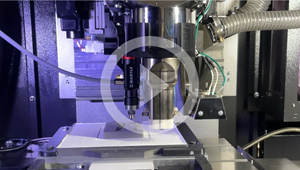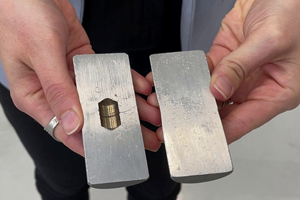Sandvik Osprey HWTS 50 Hot Work Tool Steel Developed for Enhanced Printability
The material offers improved tempering and thermal fatigue resistance as well as thermal conductivity compared to conventional H-class hot work tool steels.
Share
Sandvik’s Osprey HWTS 50 lean hot work tool steel powder was designed for enhanced printability for laser-based additive manufacturing (AM) as well as for hot isostatic pressing (HIP) and metal injection molding (MIM). The material’s tempering and thermal fatigue resistance as well as thermal conductivity are improved compared with conventional H-class hot work tool steels. The company says that these advanced properties effectively address many common challenges in hot-work applications within general engineering.
Osprey HWTS 50 improves the processability in laser powder bed fusion (LPBF), lowering the susceptibility of cold cracking compared with conventional H-class hot work tool steels. Typical applications include high-pressure die casting dies, injection molds and hot forming tools.
The chemical composition is tailored for improved hot hardness at temperatures exceeding 1112°F/600°C. It is characterized by lower carbon content compared to those of medium carbon hot work tool steels and modifications to the carbide forming elements. This is said to ensure a comparable or even enhanced tempering resistance despite lower carbon wt.%.
The thermal conductivity of Osprey HWTS 50 is higher compared to medium carbon tool steels over a wide temperature range. High thermal conductivity is beneficial for applications running at elevated temperatures, such as die casting and forging. It ensures rapid and efficient heat dissipation, resulting in faster cycles.
“Additive manufacturing is increasingly being used to produce tools and dies with near-surface conformal cooling channels,” says Faraz Deirmina, principal metallurgist in metal powder at Sandvik. “Besides optimizing processing parameters, it is important to develop chemistries specifically tailored for this technology to address fabrication challenges. Osprey HWTS 50 is designed to alleviate these challenges making it highly suitable for tooling applications at elevated temperatures. Examples are hot forming dies, extrusion and injection molding dies, and high pressure die casting dies.”
This metal powder is manufactured by either induction melting under vacuum inert gas atomization (VIGA) or melting under argon prior to inert gas atomization (IGA), producing a powder with a spherical morphology which provides good flow characteristics and high packing density. In addition, the powder has a low oxygen content and low impurity levels, resulting in a metallurgically clean product with enhanced mechanical performance.
With the alloy design philosophy in HWTS 50, using computational tools as well as a leaner chemical composition, Sandvik says it is aiming to drive the shift toward a more sustainable future. By using leaner compositions optimized through computational tools, users can increase resource efficiency and extend the lifetime of components, which in turn reduces energy consumption and CO2 emissions. Additionally, computational tools enable faster and more eco-friendly alloy development with optimized chemistries, outperforming traditional trial-and-error methods.
Key Characteristics:
- It offers improved processability in LPBF, reducing cold cracking compared to conventional hot work tool steels.
- The material has an optimized chemical composition for improved hot hardness, tempering and thermal fatigue resistance. It also has a lower carbon content and modified carbide-forming elements to ensure comparable or improved tempering resistance.
- It features thermal conductivity with approximately 35 W/mK at room temperature, providing excellent performance in high-temperature applications such as die casting and forging.
- Depending on the tempering temperature, a hardness range of 40 to 50 HRC in combination with excellent tensile and impact properties can be achieved, ensuring the longevity and durability of molds and dies under high-stress conditions.
Key application areas:
- Mold making: Injection molds
- Extrusion dies: Mandrels and cores
- Hot forging: Dies and components
- Die casting tooling: Hot gripper dies and related components
- Plastic molding: Molds and dies
- Tool holders: Various tooling applications.
- Mold repair: Rebuilding die casting molds via direct energy deposition (DED)
Related Content
With Electrochemical Additive Manufacturing (ECAM), Cooling Technology Is Advancing by Degrees
San Diego-based Fabric8Labs is applying electroplating chemistries and DLP-style machines to 3D print cold plates for the semiconductor industry in pure copper. These complex geometries combined with the rise of liquid cooling systems promise significant improvements for thermal management.
Read More3D Printing Molds With Metal Paste: The Mantle Process Explained (Video)
Metal paste is the starting point for a process using 3D printing, CNC shaping and sintering to deliver precise H13 or P20 steel tooling for plastics injection molding. Peter Zelinski talks through the steps of the process in this video filmed with Mantle equipment.
Read MoreAM 101: What Is Hot Isostatic Pressing (HIP)? (Includes Video)
Hot isostatic pressing has long been used for metal castings, but is now being applied as a valuable method for closing porosity in metal 3D printed parts.
Read MoreVulcanForms Is Forging a New Model for Large-Scale Production (and It's More Than 3D Printing)
The MIT spinout leverages proprietary high-power laser powder bed fusion alongside machining in the context of digitized, cost-effective and “maniacally focused” production.
Read MoreRead Next
3MF File Format for Additive Manufacturing: More Than Geometry
The file format offers a less data-intensive way of recording part geometry, as well as details about build preparation, material, process and more.
Read MorePostprocessing Steps and Costs for Metal 3D Printing
When your metal part is done 3D printing, you just pull it out of the machine and start using it, right? Not exactly.
Read MoreNew Equipment, Additive Manufacturing for Casting Replacement and AM's Next Phase at IMTS 2024: AM Radio #54
Additive manufacturing’s presence at IMTS – The International Manufacturing Technology Show revealed trends in technology as well as how 3D printing is being applied today and where it will be tomorrow. Peter Zelinski and I share observations from the show on this episode of AM Radio.
Read More










